Levi Eshkol
Levi Eshkol (Hebrew: לֵוִי אֶשְׁכּוֹל; ![]()
Levi Eshkol לֵוִי אֶשְׁכּוֹל | |
|---|---|
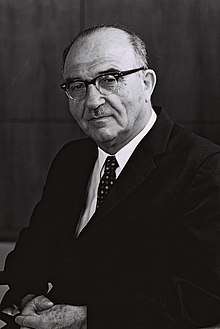 Eshkol in 1963 | |
| 3rd Prime Minister of Israel | |
| In office 26 June 1963 – 26 February 1969 | |
| President | Zalman Shazar |
| Preceded by | David Ben-Gurion |
| Succeeded by | Yigal Allon (Acting) |
| 3rd Minister of Defense | |
| In office 26 June 1963 – 5 June 1967 | |
| Prime Minister | Himself |
| Preceded by | David Ben-Gurion |
| Succeeded by | Moshe Dayan |
| 2nd Minister of Finance | |
| In office 25 June 1952 – 26 June 1963 | |
| Prime Minister | David Ben-Gurion Moshe Sharett |
| Preceded by | Eliezer Kaplan |
| Succeeded by | Pinchas Sapir |
| Leader of Mapai | |
| In office June 1963 – 23 January 1968 | |
| Preceded by | David Ben-Gurion |
| Succeeded by | Himself (as Leader of Israeli Labor Party) |
| Leader of Israeli Labor Party | |
| In office 23 January 1968 – 26 February 1969 | |
| Preceded by | Himself (as Leader of Mapai) |
| Succeeded by | Golda Meir |
| Member of the Knesset | |
| In office 20 August 1951 – 26 February 1969 | |
| Personal details | |
| Born | Levi Yitzhak Shkolnik 25 October 1895 Orativ, Kiev Governorate, Russian Empire |
| Died | 26 February 1969 (aged 73) Jerusalem, Israel [1][2] |
| Cause of death | Myocardial infarction |
| Resting place | Mount Herzl, Jerusalem, Israel |
| Nationality | |
| Political party |
|
| Other political affiliations | Alignment (1965–1968) |
| Spouse(s) | Rivka Maharshak
( m. 1922; div. 1927)Elisheva Kaplan
( m. 1930; died 1959) |
| Children | Noa Dvora Tamma Ofra |
| Signature |  |
| Military service | |
| Branch/service | Jewish Legion (1918–1920) Haganah (1920–1948) |
Eshkol was first appointed as Prime Minister following the resignation of David Ben-Gurion. He then led the party in the elections to the Sixth Knesset (1965) and won, remaining in office for six consecutive years. Shortly after taking office, he made several significant changes, among them the annulment of military rule over Israeli Arabs and a successful journey to the United States, being the first Israeli leader to be formally invited to the White House. His relations with American President Lyndon B. Johnson greatly affected Israel–United States relations and later on the Six-Day War.
Eshkol was active in the Zionist movement from a young age, immigrating to Ottoman Palestine in 1914 and working in agriculture. He was among the founders of the major institutions of the Yishuv, most importantly the Histadrut and Haganah. He was treasurer of Hapoel Hatzair political party and treasurer of the Agricultural Center. In 1929 he was elected as chairman of the settlement committee within the Zionist Congress, taking a leading role in enabling conditions for new construction. In 1937 he founded Mekorot water company and was its director until 1951. Simultaneously, he held positions at the Haganah, at Mapai and as chairman of Tel Aviv Workers' Council. In 1948–1949 he was Director General of the Ministry of Defense and from 1948–1963 he was chairman of the Settlement Department of the Jewish Agency. Elected to the Second Knesset in 1951, he was soon thereafter appointed to key government roles.
He led the Israeli government during and after the Six-Day War and was the first Israeli Prime Minister to die in office.
Biography
Early years
Levi Eshkol (Shkolnik) was born in the shtetl of Oratov, Kiev Governorate, Russian Empire (now Orativ, Vinnytsia Oblast, Ukraine). Both his parents were Jewish, although his mother Dvora (born as Dvora Krasnyanskaya) came from a Hasidic background, whereas his father Joseph Shkolnik came from a family of Mitnagdim. Both families were business-oriented and were owners of agricultural businesses including flour mills, industrial plants and forestry associated businesses.
Eshkol received a traditional Jewish education from the age of four and began Talmud studies at the age of seven. In addition to his Heder studies, Eshkol was taught by private tutors in general education. In 1911 he was accepted for studies at the Jewish gymnasium in Vilna (now Vilnius, Lithuania) and left his hometown and his family.
In Vilna, Eshkol joined the students' association Zeiri Zion (Youth of Zion) and began his connections with the Zionist movement. He was elected to the local executive committee and, in 1913, joined Hapoel Hatzair following his meeting with party leader Joseph Shprinzak.
Public activity 1914–37
In 1914, he left for Palestine, then part of the Ottoman Empire. He first settled in Petach Tikva and worked in the setting of irrigation tunnels at the local orchards. In later years he would be recalled as an excelling worker during this period of time. Eshkol also quickly became publicly active and was elected as a member of the local workers' union. However he soon thereafter left Petach Tikva, joining a small group that was set to settle the area of Atarot (Kalandia).
At the outbreak of World War I, fearing local hostility, his group settled briefly in Kfar Uria, Rishon LeZion and returning to Petach Tikva. In 1915–17 he was a leading member of the Judea Workers' Union. In 1918, he volunteered with the Jewish Legion and served in it until the summer of 1920.
In September 1920 Eshkol was among the 25 founders of Kibbutz Degania Bet, making it his permanent residence. However, his public activity had grown and he was often sent on various missions. In 1920, he was among the founders of Histadrut. He was also one of the founders of the Haganah. He was a member of the Haganah's first national high command (1920–21). As a delegate of Histadrut, he was an international representative in various gatherings and was tasked with organization of the "Agriculture Workers' Union". In 1929 he was a delegate for the first time to the Zionist Congress and was elected to the Zionist Executive, which made him an acting member of the executive in the newly formed Jewish Agency.
Between 1933–34, Eshkol was working in Berlin on behalf of the Zionist Organization and HeHalutz youth movement. During this time he negotiated with the German authorities over what became known as the Haavara Agreement. Upon his return to Palestine in 1934, he was appointed director of Nir company, which provided funds to new agricultural settlements.
Director of Mekorot
Eshkol lobbied for a national water company from circa 1930, presenting budget plans before the World Zionist Organization in 1933 and 1935. The formation of Mekorot water company was made possible in February 1937 under joint management of the Jewish Agency, Histadrut and the Jewish National Fund. Eshkol served as its director until 1951, overseeing its expansion in 1938 from agricultural territories to residential areas and the construction of the first water lines to the southern Negev area as early as 1941. By 1947, more than 200 kilometers of water lines were active.
Political and military activity 1940–49
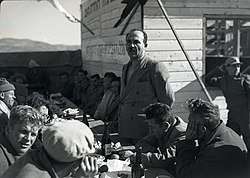
Eshkol returned to serve in the Haganah high command from 1940 to 1948 and was in charge of the organization's treasury.[4] He engaged in arms acquisition for the Haganah prior to and during the 1948 Arab–Israeli War.
Between 1942–44, Eshkol served as Secretary General of Mapai.
During the Second World War Eshkol advocated for Jewish enrollment to the British military. However, he confirmed with the Yishuv's leadership and later joined the ideology asserting differentiation between the global front and the local front, fighting against the British Mandate. In 1945–46 Eshkol was representative of Haganah in the leadership of the Jewish Resistance Movement.
In 1944 he was appointed as the Secretary General of Tel Aviv Workers' Council, remaining in this position until 1948.
In 1947 Eshkol was appointed as a member of the two major defense forums: The Negev Committee that oversaw the administration of the Negev prior to the declaration of independence of Israel, as well as the general Defense Committee of the Yishuv's leadership. Later that year, he was appointed by David Ben-Gurion to head the national recruitment center, which laid foundations to the formation of Israel Defense Forces upon independence of the State of Israel, in May 1948, at which point Eshkol was appointed Director-General of the Ministry of Defense, serving from May 1948 to January 1949.[5]
Rise to national political career
During the time of mass immigration to the State of Israel (1949–1950), Eshkol headed the Settlement Department in the Jewish Agency, where he first proposed the idea of settling a good number of these immigrants upon newly founded agricultural farms, in order to solve their housing dilemma. He is noted as saying, "We didn't know exactly what to do with these Jews. Then we interjected from the counsels of our heart, and from the experience that we had amassed thus far, and said: A desolate country, a desolate people; these two things must cause one another to blossom. From this, the idea was born to launch an extensive agricultural settlement operation and absorb a large part of the immigrants."[6] Eshkol was elected to the Knesset in 1951 as a member of Mapai party. He served as Minister of Agriculture until 1952.
In the 1959 legislative election, Eshkol coordinated Mapai's national campaign with the local party branches. He was also appointed as chairman of the party's committee on social affairs. As internal party tension was growing due to the Lavon Affair, Eshkol was asked to serve as an arbitrator.
In 1961, Ben-Gurion asked to retire as prime minister and recommended Eshkol as his successor. However, Mapai made Ben-Gurion stay. Ben-Gurion continued to lead Mapai in the 1961 legislative election but struggled to form a coalition and relied on Eshkol's negotiations with rival parties.
Minister of Finance

Following the death of Eliezer Kaplan he was appointed Finance Minister and held that position for the following 12 years. During these years, he helped form the ministry of finance, establishing the Budgets Directorate and other bodies. In 1954 he completed legislation for the establishment of the Bank of Israel.
Eshkol oversaw the implementation of Kaplan's 1952 economic plan, as well as realizing the Reparations Agreement between Israel and West Germany, which was towards its final stages of negotiation and signed in September 1952.
In 1957 he began talks with the European Economic Community towards integration of Israel in its market, ultimately achieved in 1964 with the signing of the first commercial agreement between the two entities.
In 1962 Eshkol introduced a new economic plan.
Party chairmanship
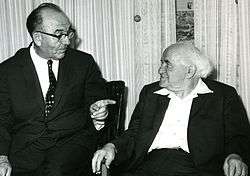
During his term as Finance Minister, Eshkol established himself as a prominent figure in Mapai's leadership, and was designated by Prime Minister David Ben-Gurion as his successor.
When Ben-Gurion resigned in June 1963, Eshkol was elected party chairman with a broad consensus and was subsequently appointed Prime Minister. However, his relationship with Ben-Gurion soon turned acrimonious over the latter's insistence on investigating the Lavon Affair, an Israeli covert operation in Egypt, which had gone wrong a decade earlier. Ben-Gurion failed to challenge Eshkol's leadership and split from Mapai with a few of his young protégés to form Rafi in June 1965. In the meantime, Mapai merged with Ahdut HaAvoda to form the Alignment with Eshkol as its head. Rafi was defeated by the Alignment in the elections held in November 1965, establishing Eshkol as the country's indisputable leader. Yet Ben-Gurion, drawing on his influence as Israel's founding father, continued to undermine Eshkol's authority throughout his term as Prime Minister, portraying him as a spineless politician incapable of addressing Israel's security predicament.
As party chairman, Eshkol formed the basis for the Alignment in 1964, the formation of the unified Israel Labor Party in 1968 and the joining of forces with Mapam to create the second alignment in 1969.
Prime minister
Eshkol formed Israel's twelfth government in 1963.[7] His first term in office saw continuous economic growth, epitomized by the opening of the National Water Carrier system in 1964. His and Finance Minister Pinchas Sapir's subsequent "soft landing" of the overheated economy by means of recessive policies precipitated a drastic slump in economic activity. Israel's centralized planned economy lacked the mechanisms to self-regulate the slowdown, which reached levels higher than expected. Eshkol faced growing domestic unrest as unemployment reached 12% in 1966, yet the recession eventually served in healing fundamental economic deficiencies and helped fuel the ensuing recovery of 1967–1973.
Upon being elected into office, Levi Eshkol fulfilled Ze'ev Jabotinsky's wish and brought his body and that of his wife to Israel where they were buried in Mount Herzl Cemetery.
Foreign relations
During his first months as premier Eshkol was engaged in a, now declassified diplomatic standoff with the United States that had begun in Ben-Gurion's term.[8] Eshkol worked to improve Israel's foreign relations, establishing diplomatic relations with West Germany in 1965, as well as cultural ties with the Soviet Union, which also allowed some Soviet Jews to immigrate to Israel. He was the first Israeli Prime Minister invited on an official state visit to the United States in May 1964.[9]
With President Johnson's administration also, represented in this case by national security aide Robert W. Komer and others, Eshkol signed what became known as the Eshkol-Comer (sic) memorandum of understanding (MOU) about Israeli nuclear capabilities. The 10 March 1965, MOU, variously interpreted since, said 'Israel would not be the first country to "introduce" nuclear weapons to the Middle East'.[10]
Six-Day War
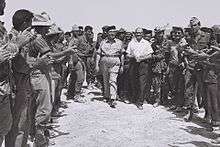
The special relationship he developed with President Lyndon Johnson would prove pivotal in securing US political and military support for Israel during the "Waiting period" preceding the Six-Day War of June 1967.[11]
According to Michael Oren, Eshkol's intransigence in the face of military pressure to launch an Israeli attack is considered to have been instrumental in increasing Israel's strategic advantage as well as obtaining international legitimacy, yet at the time he was perceived as hesitant, an image cemented following a stuttered radio speech on 28 May.[12] The Egyptian President Nasser's ever more overt provocations, created diplomatic support for Israel. Eshkol eventually established a National Unity Government together with Menachem Begin's Herut party, conceding the Defense portfolio to Moshe Dayan.[13]
Death and funeral

In the year following the war, Eshkol's health gradually declined, although he remained in power. He suffered a heart attack on 3 February 1969 from which he recovered and gradually returned to his work, maintaining meetings from the Prime Minister's official residence. In the early morning of 26 February he suffered a fatal attack from which he passed at 8:15. At his side were his wife and three physicians, including Moshe Rachmilewitz. He died in office, at the age of 73.
Eshkol was laid to rest on 28 February at Mount Herzl and was the first prime minister interred at the Great Leaders of the Nation Plot. He was the first of either presidents and prime ministers of Israel to be buried at the plot, preceded only by Eliezer Kaplan and Yosef Sprinzak.
Eshkol expressed his wishes to be buried at his Kibbutz, Deganya Bet. However, upon his passing a government meeting was convened in which the ministers expressed their support in his burial in Jerusalem. This decision was not only symbolic in its nature (following the Six-Day War), but also supported by the winter season and difficulty of performing a state funeral at the Jordan Valley as well as the War of Attrition and possible security risk at shelling aimed towards the Deganya Bet region. The government's offer was approved later that day by the Eshkol family. A second government meeting that day declared two days of national mourning, until after the state funeral. Flags across the country were brought to half mast.
Eshkol's body remained at the Prime Minister's residence in a symbolic lie in state, with an honor guard of the Israeli Police. On 27 February at 6:00, he was moved to the Knesset plaza, open to the public passing before the casket. An official state ceremony attended by dignitaries and international delegates was held in the Knesset plaza on 28 February, prior to the funeral procession to Mount Herzl.
International delegates at the funeral represented six countries:
.svg.png)
.svg.png)
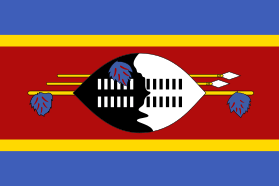



Personal life
Eshkol married three times and had four daughters:
- From his first marriage to Rivka Maharshak, he had a daughter, Noa (1924–2007). They were divorced in 1927.
- Eshkol married his second wife Elisheva Kaplan in 1930, with whom he had three daughters: Dvora Rafaeli (1930–2001), Tama Shochat and Ofra Nevo.[14] His wife Elisheva died in 1959.[15]
- In 1964 he married Miriam, a librarian at the Library of the Knesset and 35 years his junior, who passed away in 2016.
His eldest daughter Noa did not wed. From his second marriage Eshkol had eight grandchildren. His daughter Dvora married Eliezer Rafaeli and was the mother of three sons, including Prof. Sheizaf Rafaeli. His daughter Tama married Avraham Shochat, who succeeded him as minister of finance (1992–1996, 1999–2001), and had three children. His youngest daughter Ofra married Prof. Baruch Nevo and had two sons, including author Eshkol Nevo who was named after him.
Eshkol had three siblings. His brother Ben-Zion Shkolnik was a refusenik who made aliyah in 1964. Two other brothers, Lippa and Emanuel, remained in the Soviet Union. Emanuel Shkolnik was killed during combat in the Second World War while serving in the Red Army.
Public recognition
Honors
Eshkol was given honorary citizenships of towns and cities in Israel and abroad: Philadelphia (1964),[16] Chicago (1964),[17] El Paso (1964), Tirat Carmel (1965), Kiryat Gat(1965),[18] Nazareth Ilit (1965),[19] Beer Sheva (1965),[20] Beit Shean (1965),[21] Afula (1965),[22] Dimona (1967),[23] Ashdod (1968),[24] Jerusalem (1968),[25] Petach Tikva (1968)[26]
He was awarded with honorary doctorates by the Hebrew University of Jerusalem (1964),[27] Roosevelt University (1964),[28] Yeshiva University (1964),[29] University of Liberia (1966)[30] and Hebrew Union College (1968).[31]
Commemoration

Since 1970, Yad Levi Eshkol is the official organization commemorating prime minister Eshkol. It holds educational activities in his memory, maintains his papers and personal archive, supports academic research relating to Eshkol and, since 2016, operates the historical building in Jerusalem that served as the former prime minister's residence and now houses a visitors' center in memory of Eshkol.
Numerous national sites have been named after him:
- Eshkol Regional Council in the north-western Negev.
- Eshkol National Park near Beersheba.
- Eshkol Power Station.
- Eshkol Water Filtration Plant, the central water filtration facility of the National Water Carrier.
Streets and neighborhoods have been named in his honor, among them the Ramat Eshkol neighborhood in Jerusalem. Several schools are also named after him, including HaKfar HaYarok. The Hebrew University of Jerusalem named the Agriculture Faculty in Levi Eshkol's name, as well as established a research institute in his name in the Faculty of Social Sciences.
Israel issued in 1970 a postage stamp with a portrait of Eshkol. In 1984 his image was chosen for the five-thousand old Israeli shekel bill, replaced in 1985 by the five new Israeli shekel bill. Since 1990, his image is found on a limited, yet circulated, minting of the five new Israeli shekel coin that replaced the bill.
Gallery
 Public speaking, 1954
Public speaking, 1954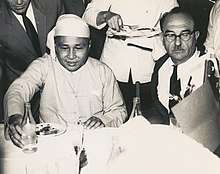 With U Nu, 1955
With U Nu, 1955 With Ben-Gurion and Pinchas Sapir, 1956
With Ben-Gurion and Pinchas Sapir, 1956 With Senator Robert Kennedy, 1960
With Senator Robert Kennedy, 1960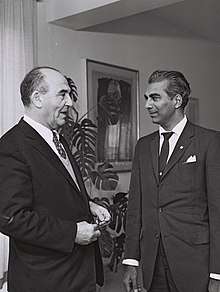 With Cheddi Jagan, 1961
With Cheddi Jagan, 1961 With Shimon Peres
With Shimon Peres With Mrs. Eshkol and Adlai Stevenson, 1964
With Mrs. Eshkol and Adlai Stevenson, 1964 Formation of the Alignment, 1965
Formation of the Alignment, 1965_-_P.M._Levy_Eshkol_meets_the_sheiks_of_the_Bedouin_tribes.jpg) With Bedouin dignitaries, 1965
With Bedouin dignitaries, 1965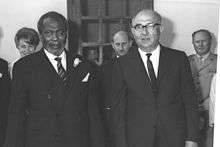 With Jomo Kenyatta, 1966
With Jomo Kenyatta, 1966 With Yitzhak Rabin, 1966
With Yitzhak Rabin, 1966 Yad Levi Eshkol in Jerusalem
Yad Levi Eshkol in Jerusalem
References
- https://www.nytimes.com/1969/02/26/archives/levi-eshkol-is-dead-of-a-heart-attack-led-israel-since-63-levi.html
- https://www.jta.org/1969/02/27/archive/levi-eshkol-israels-third-premier-dead-at-73-allon-named-to-serve-temporarily
- Gal Perl Finkel, Wars are won by preparation and not by courage alone, The Jerusalem Post, 8 April 2017.
- "Archived copy". Archived from the original on 16 March 2016. Retrieved 4 January 2012.CS1 maint: archived copy as title (link)
- "Levi Eshkol" Archived 9 April 2016 at the Wayback Machine, Israel Ministry of Foreign Affairs web site.
- Levi Eshkol, the Third Prime-Minister: A Selection of Documents Covering his Life [Heb. (לוי אשכול - ראש הממשלה השלישי : מבחר תעודות מפרקי חייו (1895-1969], ed. Y. Rosental, A. Lampron & H. Tzoref, Israel State Archives (publisher): Jerusalem 2002, chapter 6 - In the Jewish Agency, During the Years of Mass Immigration (Hebrew)
- "New Israel Cabinet Sworn into Office in Knesset; German Issue Raised". JTA. 27 June 1963. Retrieved 7 July 2013.
- Cohen, Avner (3 May 2019). "How a Standoff with the U.S. Almost Blew up Israel's Nuclear Program". Haaretz.
- A house with a legacy, Jerusalem Post
- Avni, Benny,"Iran and Syria Eye Israel’s Nukes" Archived 21 January 2016 at the Wayback Machine, Newsweek, 17 October 2013. This source and others misspell Komer's last name. For confirmation of correct spelling/identification, for example Cohen, Avner, Israel and the Bomb Archived 5 May 2016 at the Wayback Machine (Columbia University Press) p. 207; or Hersh, Seymour, The Samson option: Israel's nuclear arsenal Archived 12 May 2016 at the Wayback Machine (NY: Random House, 1991), p. 134; both via Google Books. Retrieved 2015-04-04.
- Avner, Yehuda (2010). The Prime Ministers: An Intimate Narrative of Israeli Leadership. The Toby Press. p. 599. ISBN 978-1-59264-278-6.
- Oren, Michael B. (2003). Six Days of War: June 1967 and the Making of the Modern Middle East. New York: Random House. p. 316. ISBN 0-345-46192-4.
- Tucker, Spencer C.; Roberts, Priscilla (12 May 2008). The Encyclopedia of the Arab-Israeli Conflict: A Political, Social, and Military History [4 volumes]: A Political, Social, and Military History. ABC-CLIO. ISBN 9781851098422.
- http://www.haaretz.com/hasen/spages/1118230.html "Perpetual Motion: Noa Eshkol"
- "Levi Eshkol AKA Levi Shkolnik" Archived 3 March 2016 at the Wayback Machine, nndb.com.
- "אשכול ייפגש פעמיים עם ג'ונסון" [eshkol will meet twice with Johnson]. HaZofe (in Hebrew). 26 May 1964.
- "אשכול סיים ביקורו בארצות הברית" [Eshkol concluded his visit in the United States]. Herut (in Hebrew). 12 June 1964.
- "אזרחות כבוד של קרית גת ללוי אשכול" [Honorary citizenship of Kiryat Gat to Levi Eshkol]. Herut (in Hebrew). 24 June 1965.
- "אזרחות כבוד ללוי אשכול בנצרת עילית" [Honorary citizenship for Levi Eshkol at Nazareth Ilit]. Al HaMishmar (in Hebrew). 13 July 1965.
- "ראש הממשלה לוי אשכול אזרח כבוד של באר שבע" [Prime Minister Levi Eshkol honorary citizen of Beer Sheva]. Al HaMishmar (in Hebrew). 5 August 1965.
- "אשכול יבקר היום בבית שאן" [Eshkol to visit tody in Beit Shean]. Davar (in Hebrew). 25 August 1965.
- "אזרחות כבוד של עפולה לאשכול" [Honorary citizenship of Afula to Eshkol]. HaZofe (in Hebrew). 13 October 1965.
- "אשכול - אזרח כבוד של דימונה" [Eshkol - Honorary citizen of Dimona]. Maariv (in Hebrew). 19 January 1967.
- "אשכול - אזרח כבוד של אשדוד" [Eshkol - Honorary citizen of Ashdod]. Davar (in Hebrew). 30 April 1968.
- "ל. אשכול - אזרח כבוד של ירושלים השלמה" [L. Eshkol - Honorary ciztien of united Jerusalem]. Davar (in Hebrew). 27 May 1968.
- "אשכול קיבל אזרחות כבוד של פתח תקוה" [Eshkol given honorary citizenship of Petach Tikva]. Davar (in Hebrew). 6 June 1968.
- "תואר ד"ר כבוד ללוי אשכול" [Honorary doctorate to Levi Eshkol]. Al HaMishmar (in Hebrew). 12 March 1964.
- "אשכול ייפגש פעמיים עם ג'ונסון" [Eshkol will meet twice with Johnson]. HaZofe (in Hebrew). 26 May 1964.
- "אשכול סיים ביקורו בארצות הברית" [Eshkol concluded his visit in the United States]. Herut (in Hebrew). 12 June 1964.
- "אשכול פותח סיורו באפריקה" [Eshkol begins his tour in Africa]. HaZofe (in Hebrew). 29 May 1966.
- "מסע אשכול" [Journey of Eshkol]. Davar (in Hebrew). 19 January 1968.
Further reading
Authored books
- Eshkol, Levi (1958). The Birth Pangs of Settlement (in Hebrew). Am Oved.
- Eshkol, Levi (1965). Up the Road (in Hebrew). Ayanot.
- Eshkol, Levi (1969). The Covenant of the Land (in Hebrew). Tarbut ve Hinuch.
In English
- Aronson, Shlomo (2010). Levi Eshkol: From Pioneering Operator to Tragic Hero – A Doer. Vallentine Mitchell.
- Avner, Yehuda (2010). The Prime Ministers: An Intimate Narrative of Israeli Leadership. Toby Press. ISBN 978-1-59264-278-6. OCLC 758724969.
- Prittie, Terence (1969). Eshkol: The Man and the Nation. Pitman.
In Hebrew
- Israel State Archive (2001). Levi Eshkol: Third Prime Minister (1895–1969) (in Hebrew). Israel State Archive.
- Ben-Horin, Daniel (2017). Intelligence of the Hesitant: The Life and Views of the Third Prime Minister (in Hebrew). Orion.
- Eshkol-Nevo, Ofra (1988). A Token of Humor (in Hebrew). Idanim.
- Giladi, Dan (1993). Levi Eshkol: Captain of Mass Settlement, 1948–1952 (in Hebrew). Golda Meir Institute.
- Goldstein, Yossi (2003). Eshkol: Biography (in Hebrew). Keter.
- Lammfrom, Arnon (2014). Levi Eshkol: Political Biography, 1944–1969 (in Hebrew). Resling.
- Lufpban, Hezi (1965). Eshkol (in Hebrew). Am Oved.
- Manor, Alexander (1965). Levi Eshkol Sayings (in Hebrew). Orli.
- Medved, Dov (2004). Levi Eshkol, State and Party, 1948–1953 (in Hebrew). Ben-Gurion University of the Negev. Text has an English summary.
- Rosenman, Avraham (1969). The Lights: Ruppin and Eshkol (in Hebrew). Masada.
- Shapiro, Yosef (1969). Levi Eshkol: Within Public Service (in Hebrew). Masada.
External links
| Wikimedia Commons has media related to Levi Eshkol. |
- Levi Eshkol on the Knesset website
- Yad Levi Eshkol - the official commemorative organization website
- Levi Eshkol's biography Knesset website (in English)
- Short Biography of Levi Eshkol from the Jewish Virtual Library
- The Central Zionist Archives in Jerusalem site. Office of Levi Eshkol, Jerusalem (S43), Office of Levi Eshkol, Tel Aviv (S63).
- "Levi Eshkol, Forgotten Hero" – Essay from Azure: Ideas for the Jewish Nation
- Decisions of Levi Eshkol's cabinet after the Six Day War, Israel State Archives website.
| Political offices | ||
|---|---|---|
| Preceded by Pinhas Lavon |
Minister of Agriculture 1951–1952 |
Succeeded by Peretz Naftali |
| Preceded by Eliezer Kaplan |
Minister of Finance 1952–1963 |
Succeeded by Pinchas Sapir |
| Preceded by David Ben-Gurion |
Minister of Defense 1963–1967 |
Succeeded by Moshe Dayan |
| Prime Minister of Israel 1963–1969 |
Succeeded by Yigal Allon Acting | |
| Preceded by Yosef Almogi |
Minister of Construction 1965–1966 |
Succeeded by Mordechai Bentov |
| Party political offices | ||
| Preceded by David Ben-Gurion |
Leader of Mapai 1963–1968 |
Party dissolved |
| New political party | Leader of Israel Labor Party 1968–1969 |
Succeeded by Yigal Allon Acting |